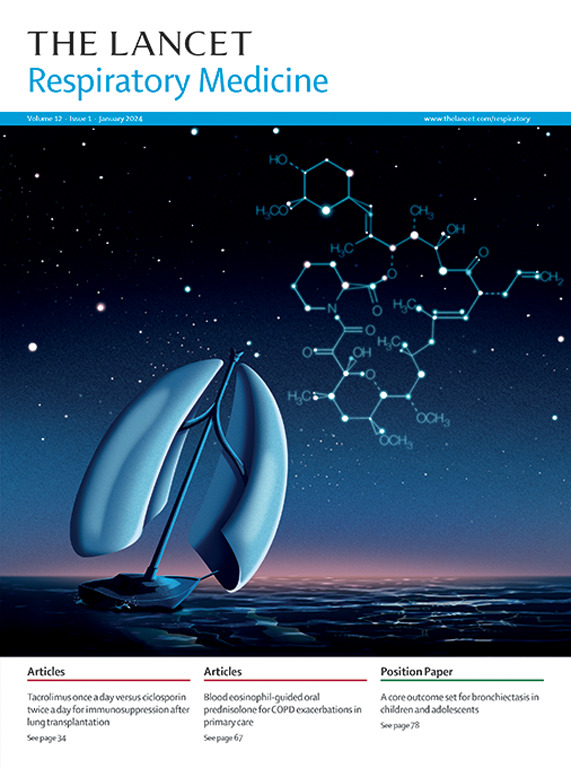Preoxygenation strategies for intubation of patients who are critically ill: a systematic review and network meta-analysis of randomised trials
IF 38.7
1区 医学
Q1 CRITICAL CARE MEDICINE
引用次数: 0
Abstract
Background
Preoxygenation is a crucial preparatory step for intubation. Several strategies for preoxygenation exist, including facemask oxygen, high-flow nasal cannula (HFNC), and non-invasive positive pressure ventilation (NIPPV). However, the comparative efficacy of these strategies remains largely uncertain. We aimed to compare the efficacy and safety of HFNC, NIPPV, and facemask oxygen for preoxygenation of patients who are critically ill requiring tracheal intubation.Methods
In this systematic review and network meta-analysis, we searched Embase, MEDLINE, Web of Science, Scopus, and Cochrane Central Register of Controlled Trials for randomised clinical trials published from database inception until Oct 31, 2024, with no language restrictions. We included randomised controlled trials that compared HFNC versus NIPPV, HFNC versus facemask oxygen, or NIPPV versus facemask oxygen in adult patients (age ≥18 years) who were critically ill requiring intubation in the intensive care or emergency department setting. We had no additional eligibility criteria for our network meta-analysis. We used Covidence software to screen eligible trials. Two reviewers independently screened trials for titles and abstracts, and then subsequently screened full-text reports. Discrepancies were resolved by discussion or a third party adjudicator. Summary-level data were extracted manually using a structured data collection form. Outcomes of interest were hypoxaemia during intubation, successful intubation on the first attempt, serious adverse events, and all-cause mortality. We performed a frequentist random-effects network meta-analysis. We assessed the risk of bias using the modified Cochrane tool (RoB 2.0) and the certainty of evidence using the GRADE approach. The protocol is registered on the Open Science Framework.Findings
We initially identified 6900 records, of which 48 were assessed via full-text screening, and 15 eligible studies with 3420 patients were included in our systematic review and network meta-analysis. Findings suggested that use of NIPPV for preoxygenation probably reduces the incidence of hypoxaemia during intubation versus HFNC (relative risk 0·73 [95% CI 0·55–0·98]; p=0·032; moderate certainty) and reduces the incidence of hypoxaemia versus facemask oxygen (0·51 [0·39–0·65]; p<0·0001; high certainty). HFNC for preoxygenation reduces the incidence of hypoxaemia during intubation versus facemask oxygen (0·69 [0·54–0·88]; p=0·0064; high certainty). None of the preoxygenation strategies affected the incidence of successful intubation on the first attempt (all low certainty). None of the preoxygenation strategies appeared to affect all-cause mortality (very low-to-moderate certainty). NIPPV probably reduces the risk of serious adverse events versus facemask oxygen (0·30 [0·12–0·77]; p=0·011; moderate certainty) and might reduce the risk of serious adverse events versus HFNC (0·32 [0·11–0·91]; p=0·035; low certainty). HFNC might not reduce the risk of serious adverse events versus facemask oxygen (0·95 [0·60–1·51]; p=0·83; low certainty).Interpretation
Preoxygenation with NIPPV or HFNC rather than facemask oxygen might prevent hypoxaemia during tracheal intubation of adults who are critically ill. Compared with HFNC, NIPPV probably decreases the incidence of hypoxaemia during intubation. Our findings will inform updated international guidelines on preoxygenation.Funding
None.危重患者插管预充氧策略:随机试验的系统回顾和网络荟萃分析
背景预充氧是气管插管的重要准备步骤。预充氧有几种策略,包括面罩供氧、高流量鼻插管(HFNC)和无创正压通气(NIPPV)。然而,这些策略的相对功效在很大程度上仍然不确定。我们的目的是比较HFNC、NIPPV和面罩氧用于需要气管插管的危重患者预充氧的有效性和安全性。方法在本系统评价和网络荟萃分析中,我们检索了Embase、MEDLINE、Web of Science、Scopus和Cochrane Central Register of Controlled Trials,检索了从数据库建立到2024年10月31日发表的随机临床试验,没有语言限制。我们纳入了随机对照试验,比较HFNC与NIPPV、HFNC与面罩供氧,或NIPPV与面罩供氧在重症监护室或急诊科需要插管的危重成人患者(年龄≥18岁)中的应用。我们的网络荟萃分析没有额外的资格标准。我们使用covid软件筛选符合条件的试验。两位审稿人独立筛选试验的标题和摘要,然后筛选全文报告。分歧通过讨论或第三方裁决来解决。使用结构化数据收集表单手动提取摘要级数据。值得关注的结果是插管时低氧血症、第一次插管成功、严重不良事件和全因死亡率。我们进行了频率随机效应网络元分析。我们使用改进的Cochrane工具(RoB 2.0)评估偏倚风险,使用GRADE方法评估证据的确定性。该协议已在开放科学框架上注册。我们最初确定了6900条记录,其中48条通过全文筛选进行了评估,15项符合条件的研究纳入了3420名患者,纳入了我们的系统评价和网络荟萃分析。研究结果表明,与HFNC相比,使用NIPPV进行预充氧可能减少插管期间低氧血症的发生率(相对危险度0.73 [95% CI 0.55 - 0.98];p = 0·032;中度确定性),与面罩供氧相比,可降低低氧血症的发生率(0.51 [0.39 - 0.65];术;0·0001;高确定性)。与面罩供氧相比,HFNC预充氧可降低插管期间低氧血症的发生率(0.69 [0.54 - 0.88];p = 0·0064;高确定性)。所有预充氧策略均不影响首次插管成功的发生率(均为低确定性)。预充氧策略似乎没有影响全因死亡率(非常低到中等的确定性)。与面罩供氧相比,NIPPV可能降低了严重不良事件的风险(0.30 [0.12 - 0.77];p = 0·011;中度确定性),与HFNC相比,可能降低严重不良事件的风险(0.32 [0.11 - 0.91];p = 0·035;低确定性)。与面罩供氧相比,HFNC可能不会降低严重不良事件的风险(0.95[0.60 - 1·51];p = 0·83;低确定性)。用NIPPV或HFNC预充氧而不是面罩供氧可以预防危重成人气管插管期间的低氧血症。与HFNC相比,NIPPV可能降低了插管期间低氧血症的发生率。我们的研究结果将为最新的预充氧国际指南提供信息。
本文章由计算机程序翻译,如有差异,请以英文原文为准。
求助全文
约1分钟内获得全文
求助全文
来源期刊

Lancet Respiratory Medicine
RESPIRATORY SYSTEM-RESPIRATORY SYSTEM
CiteScore
87.10
自引率
0.70%
发文量
572
期刊介绍:
The Lancet Respiratory Medicine is a renowned journal specializing in respiratory medicine and critical care. Our publication features original research that aims to advocate for change or shed light on clinical practices in the field. Additionally, we provide informative reviews on various topics related to respiratory medicine and critical care, ensuring a comprehensive coverage of the subject.
The journal covers a wide range of topics including but not limited to asthma, acute respiratory distress syndrome (ARDS), chronic obstructive pulmonary disease (COPD), tobacco control, intensive care medicine, lung cancer, cystic fibrosis, pneumonia, sarcoidosis, sepsis, mesothelioma, sleep medicine, thoracic and reconstructive surgery, tuberculosis, palliative medicine, influenza, pulmonary hypertension, pulmonary vascular disease, and respiratory infections. By encompassing such a broad spectrum of subjects, we strive to address the diverse needs and interests of our readership.
 求助内容:
求助内容: 应助结果提醒方式:
应助结果提醒方式:


